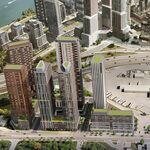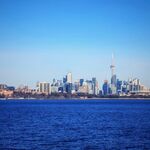Island life coming to Humber?
The earth dug out for the Eglinton light rail transit line could be turned into islands in Lake Ontario.
At least that’s one proposal as the city considers ways to improve the water quality off some of Toronto’s Lake Ontario beaches.
The string of islands would go in at the mouth of the Humber River and extend about one kilometre from shore. The plan would take clean fill from construction jobs to build a solid earth barrier underwater that would deflect polluted Humber River water out into the lake and away from Sunnyside Beach.
Above the water, the feature would look like a string of small islands that could be landscaped, support wildlife and made accessible to the public, city councillors on the public works committee were told Tuesday.
“You could design this to have pedestrians come out to the islands,†said Toronto Water general manager Lou Di Gironimo.
“You could connect the islands. There’s many ways to design them, we could make it a very attractive feature.â€
Final plans would depend on what comes out of a $3 million environmental assessment of the Humber concept and a similar plan to build a stormwater management wetland at the Ashbridge’s Bay sewage treatment plant.
If approved by council, the environmental assessment could begin next year and allow detailed design to begin in late 2014, the committee was told.
In 2002, the city opened the Western Beaches Tunnel, which captures polluted stormwater runoff so that it can be treated. That has improved Sunnyside water quality but not enough to qualify as a blue flag swimming beach. The designation is given to beaches that meet strict criteria for water quality and environmental management.
Diverting the Humber River flow away from Sunnyside would allow the beach to consistently meet swimming standards.
The project would also provide a home for up to 2 million cubic metres of soil excavated from construction sites, and address the growing shortage of places to put fill.
The city’s water department expects to generate 800,000 cubic metres of clean fill over 10 years from digging trenches for watermain and sewer projects.
The Eglinton Crosstown transit line alone is expected to produce another 800,000 cubic metres.
The water department’s report said “contractors now have to transport excavated material well outside the city for disposal, ultimately resulting in higher construction costs for city projects associated with the increased haulage costs and tipping fees.â€
http://www.thestar.com/news/transportation/article/1156248--island-life-coming-to-humber



















